Introduction
Agriculture is vitally important for the continuation of humanity, as it is necessary for people’s healthy and balanced nutrition. Essentially, this is also the reason why agriculture has strategic importance (Terzi et al., 2019). For sustainable agriculture, agricultural practices need to be performed with technological tools and methods.
Developments of countries are possible with the most productive use of production resources (Rehber & Tipi, 2016; Rehber & Erkuş, 2020). Determining the current situation by analyzing resource utilization in the agricultural sector is important with respect to the efficient use of resources and agricultural growth. In a research conducted in China, it was mentioned that China’s agriculture has progressed remarkably in recent years has accelerated. This growth is mainly due to the efficient use of resources rather than to the expansion of cultivated area (Fan et al., 2011; Chopra et al., 2022).
Yozgat province where the fieldwork was carried out is an important agricultural region in Turkey (Erbaş, 2021). It has 2.56% of the total agricultural area and 2.65% of the total cereal production. It is farmed in 44.47% (598.059 ha) of the surface area. Despite rural migrations, more than 1/3 of the total population still lives in rural areas (Erbaş, 2016). 26.5% of the active population was employed in the agricultural sector in 2017 (TSI, 2017).
However, the statistical data for the period 2001-2021 show that the agricultural area, the rural population, and the number of farms in the area decreased significantly. The total arable agricultural area has decreased by 25.0%, the total field land by 41.06%, the rural population by 34.11%, and the number of farms by 32.25% in the region in two decades (TSI, 2021). These developments were important indicators of the abandonment of agricultural land.
Agricultural land abandonment is a gradual process where farming intensity is reduced leading to underutilization and finally complete termination of agricultural activities (Subedi et al., 2022). Leal Filho et al. (2017), in their study, stated that abandonment of agricultural land can be defined as the cessation of agricultural activities on a given surface of the land.
There are many studies on the abandonment of agricultural land in the literature, such as the one conducted by Benayas et al. (2007), who examined the basic causes of agricultural land abandonment (socioeconomic reasons and migration, soil erosion, unadapted agricultural systems, and land mismanagement). The review covered regions such as Puerto Rico, Tanzania, Brazil, the tropics, Spain, Wisconsin, Swiss Mountains. According to them, agricultural land abandonment brings with it many problems, which are biodiversity loss, increased fire frequency and density, soil erosion and desertification, loss of cultural and/or aesthetic values, falling away landscape variety, and limitation of water provision. On the other hand, Hobbs and Cramer (2007) investigated what causes the abandonment of land under agricultural management. According to them, although causal factors causing land abandonment vary by region, they are often a mix of social, economic, and ecological factors. Agricultural systems should be considered complex systems, but land abandonment occurs due to simple and compensable reasons. In a study conducted in Slovakia by Masny and Zauskova (2014), it was stated that land abandonment has several serious impacts. Agricultural land abandonment threatens traditional cultural farmland and causes a decrease in biodiversity. In this topic, particularly UNESCO is of key importance in ecosystem management, protection of cultural heritage and biodiversity, and integration with traditional knowledge management of them. According to Leal Filho et al. (2017), land abandonment is one possible outcome of a process of marginalization driven by a combination of social, economic, political, and environmental factors. According to Du et al. (2021), abandoning and not cultivating agricultural lands can cause different consequences, and pose a threat to farmland diversity and food security. These changes can lead to the loss of agricultural biodiversity and cultural landscapes. However, abandonment can also help accelerate ecological restoration and increase carbon sequestration.
Agriculture land abandonment or underuse is a widespread issue, particularly in Southeast Europe and the Caucasus (Fayet et al., 2022). A variety of detrimental socio-economic and environmental effects of land abandonment include a threat to food security, lost economic possibilities, and other adverse effects (Dimopoulos et al., 2023). In addition to compromising food security and leading to missed economic opportunities, land abandonment has a number of detrimental socioeconomic and environmental effects. Due to cropland degradation and loss, rapid population expansion, and unequal economic growth (poverty and overconsumption), agricultural output in Turkey is not sustainable (Korkanç, 2018). A number of issues, including employment, erroneous movement from rural to urban regions, a decline in plant diversity, and desertification, have arisen as a result of the abandonment of agricultural fields. Policymakers are concerned about these issues (Benayas et al., 2007; Majchrowska, 2013). Inability to adjust to urban life, loss of traditional and cultural values, home employment, and a lack of skilled labor are other issues that the farming community must deal with. Socioeconomic and political issues are expected to have a significant impact on abandonment (Afanasjeva et al., 2023). In order to better understand all of the issues that agricultural land abandonment discloses, this study intends to look into the factors that contribute to it in general. The methodology applied in the study is based on both qualitative and quantitative issues. Thus, the study will be a guide for research to be conducted in agricultural and social fields and, policymakers. This work adds to the body of knowledge in four different ways. First of all, it starts off by offering reliable information on how farms and good enterprises use land resources. Secondly, it also provides comprehensive remedies for the problem of abandoned agricultural areas. Thirdly, it suggests a comprehensive framework to guarantee the sustainability of farm resources. Fourthly, this research adds to the range of institutional approaches to developing and implementing fresh agricultural policy.
In this context, agricultural lands need to be protected. Protecting agricultural land holds great significance in meeting the food needs of societies and the sustainability of agriculture. Even if the subject is only approached from this point of view, the protection of agricultural lands will be highly important. Protecting lands is also very important for the sustainability of agriculture. Sustainability encourages ecological responsibility, economic efficiency, and social solidarity (Keskin & Dellal, 2011; Purvis, 2019; Schaller, 1993). Sustainability depends on good support policies, encouraging farming, stabilizing input prices, growing crops of high productivity, and above all, is possible by giving the necessary consequences to farming. The importance of sustainable agriculture at the global level is due to the shortage of world natural resources, climate change, other uses of food, and increasing food prices (Khor, 2009; Adenle et al., 2019). Sustainable agriculture is crucial for economic, social, and environmental development (Robertson, 2015; Velten et al., 2015; Brodt et al., 2011).
The study consists of five main headings, including the introduction. Materials and methods after the introduction in which general information about the subject is given are presented in the second section. In materials and methods, the materials used in the study and the methods applied are explained. Results are given in the third section of the study. In this section, information on the reasons for producers’ abandonment of farmland and sustainability is presented. The discussion, in which all the results of the research are compared and explained with the results of other studies, is given in the fourth section. The fifth chapter consists of conclusions.
Methodology
The principal material of this research consisted of the surveys implemented on the farms identified through a stratified random sampling method in Yozgat province. These data obtained via surveys formed the primary data of this research. The field survey was run in the period 2017-2018 and filled by meeting face to face with farms.
The research could have been conducted in a wider area to cover the Central Anatolian Region. However, because conducting fieldwork in a large area was rather difficult in terms of cost and time, it could not be accomplished.
In the study, it was also benefited from the data of other national and international organizations, and particularly the data of the Turkey Statistical Institute (TSI). These were the secondary data resources of the study.
In the research, the main population was determined by records of Provincial and District Directorates of Agriculture and Forestry. Later, (with the opinions of the technical staff of these institutions and especially field experts) four districts were determined by purposed sampling. Thus, four districts (Centre Town, Yerköy, Şefaatli, and Sorgun) were selected as the research region (Figure 1). In determining the villages in the research cover, it was significantly benefited from the opinions of field experts in the Provincial and District Directorates of Agriculture. In the determination of the socioeconomic aspect of the research area also, information exchanged with some institutions was effective significantly.
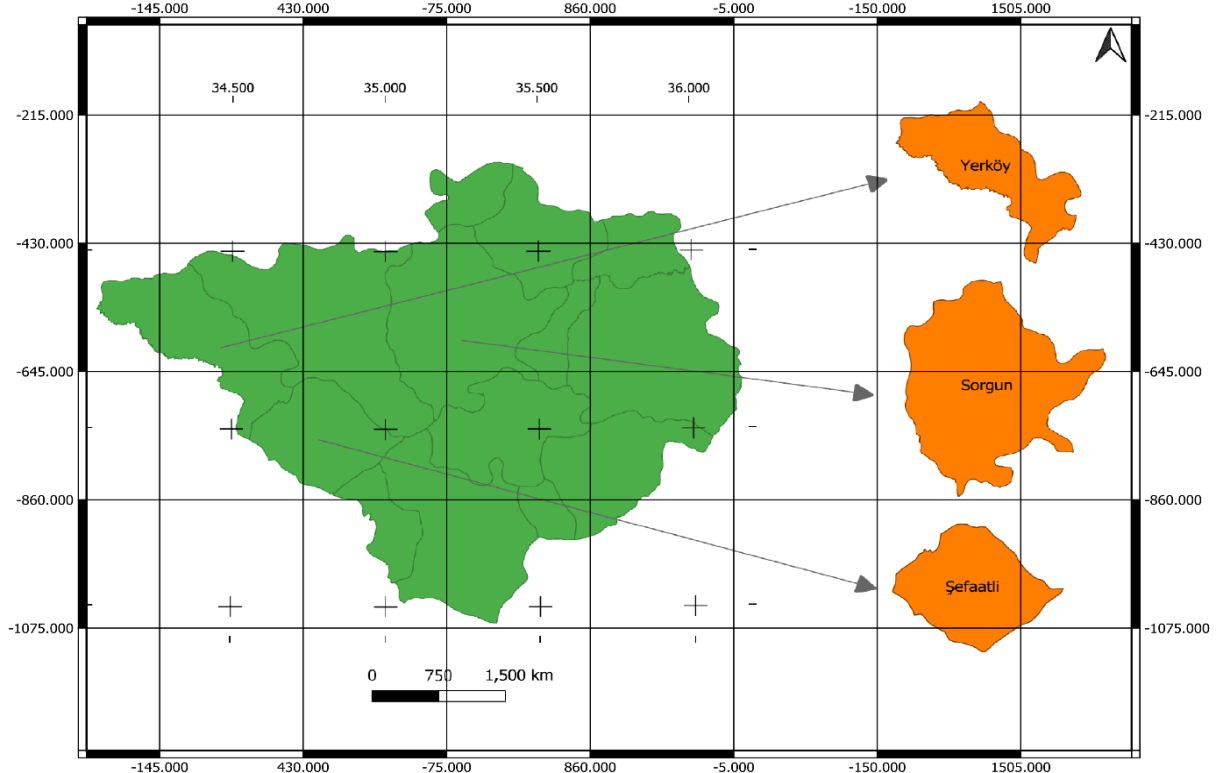 Figure 1
Research Area (Yozgat Province and Districts, Turkey)
Figure 1
Research Area (Yozgat Province and Districts, Turkey)
Note. There are Yerköy districts in the southwest, Sorgun in the west, and Şefaatli districts in the south of Center Town. Center Town is between “39.8210” latitude and “34.8086” longitude coordinates, Yerköy is between “39.641605” latitude and “34.469417” longitude coordinates, Sorgun is between “39.812817” latitude and “35.190378” longitude coordinates, and Şefaatli is between “39.500481” latitude and “34.758217” longitude coordinates.
Source: Own elaboration.
The total number of farms in the research area constituted the total population of this research. The sample size was determined in accordance with the stratified random sampling method. The following formulas were used in this method (Yamane, 2006).
The terms in the formulas could be explained as below.
-
d: Error margin
-
Z: Standard normal distribution table value according to error margin
-
N: Number of units in population
-
Sh2: Variance of the strata
-
Sh: Standard deviation of the strata
-
Nh: Distribution of number of units in population to the strata
-
n: Sampling size
-
nh: Distribution of sampling size to the strata
In stratified random sampling, the farms (very small or very big farms) that were against the distribution were excluded from the sampling. The sampling volume was designated as 181 by considering an error margin of 5% and a confidence interval of 95.
Research questions are important in exploring determinants of land abandonment and in determining the administrative competencies of farms and the success of farm management. Surveys prepared in accordance with the purpose of the research consisted of the following types of questions:
-
An open-ended question: is a type of question in which the researcher requests his/her opinions about a topic without offering any choice to the respondent (Kazan et al., 2016; Kıncal et al., 2022). At the survey stage, the respondent was asked to reply to such questions in his/her own statement.
-
A closed-ended question: is the type of question in which the researcher offers a set of specific and predetermined reply choices to the respondent (Kazan et al., 2016; Kıncal et al., 2022). At the survey stage, the respondent was asked to mark the most appropriate choice.
Closed-ended questions consisted of the following types of questions:
-
Two-choice questions: were questions whose answers were with two options “yes or no”.
-
Multiple choice questions: These were questions whose answers consisted of more than two options.
-
Measure-type questions: were also the questions in which the respondent was asked to choose his/her opinion on a particular subject from among options graded from least to most.
Before conducting the surveys, the producers were informed for what purpose the surveys would be conducted. After that, they consented to have their answers used for the research. This consent was verbal. Thus, loyalty and confidence in the research were brought into. The survey forms were filled out by meeting face-to-face with the producers. Qualitative interview questions were prepared by taking into consideration the theoretical frame related to the subject of the research, the socioeconomic and agricultural structure of the region, the researcher’s recognition of the region well, and the purpose of the research. In qualitative questions, answers to questions within the sampling were grouped according to their similarities, regardless of the sample size.
After the surveys were completed, survey data were analyzed in a computer-based program. Summary tables were created from the analysis of the survey data, and they were evaluated separately according to the strata. Summary tables consisted of soil analysis and fertilizer use, attendance at agricultural courses/meetings, taking technical support, cropping system, administrative competence, the annual revenue and costs. From the qualitative data also, findings on sustainability were reached. In the analysis process of the data, it significantly benefited from descriptive statistics (arithmetic mean, index, percentage, etc.). Whether the above-mentioned farm practices differ between strata was tested statistically.
Some of the terms used in the calculation of income and expenses in wheat cultivation are listed below.
Gross production value: the value consisting of the values of plant and animal products produced in agricultural enterprises and the increase in the value of fixtures during the year (Özçelik, 2019). For wheat cultivation, this consisted of plant (wheat) production value.
•  (4)
(4)
Fixed costs: are costs incurred regardless of the amount of production of a farm (Cinemre & Kılıç, 2015). These include amortization, repair and maintenance costs of buildings, general management costs, permanent labor costs, and family labor costs.
Variable costs: costs that increase or decrease depending on the amount of production (Cinemre & Kılıç, 2015). These include seed, fertilizer, fuel and oil, machinery repair and maintenance costs, agricultural pesticides and marketing, transportation, and temporary labor costs. It should be noted that 3% of the variable costs were taken in the computation of general management costs.
Total costs were calculated by adding fixed and variable costs.
•  (5)
(5)
Gross profit was found by deducting variable costs from the gross production value (Rehber & Tipi, 2016).
•  (6)
(6)
Net profit was calculated by deducting total costs from the gross production value (Rehber & Vural, 2018).
• (7)
(7)
Relative profit was found by dividing the gross production value by total costs (Erkuş & Demirci, 1996).
• (8)
(8)
Tables consisting of questions with two options were scored as (0-1), those with three options as (0-1-2), and those with five options as (1-2-3-4-5). Later, a frequency group (1-5; 6-10; 11-15) was formed, and their administrative profiles were determined as low-profile, mid-profile, and high-profile as follows:
1-5 points: low-profile farms,
6-10 points: mid-profile farms,
11-15 points: high-profile farms.
Farms’ administrative profiles were determined by strata and given in Table 1.
Table 1
Farms’ admınıstratıve profıles by strata
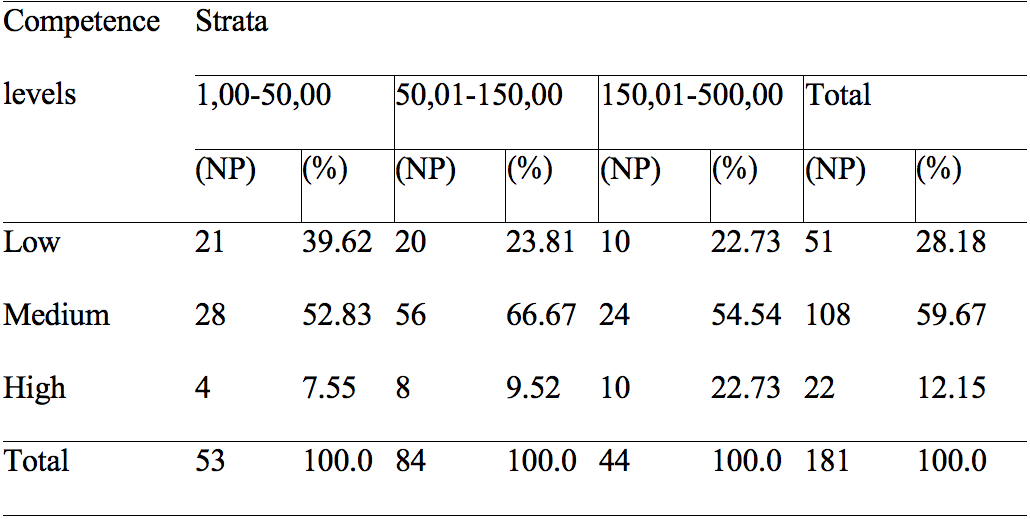
Source: Own elaboration.
The strata concept mentioned in the tables is the grouping of farms included in the sample according to farm size groups. A decare is a unit of land measurement equivalent to 1000 m2. Ten decares is one hectare.
Analysis of Results
Abandonment of Farmland Due to Reaping Low Profit from Arable Crops Farming
In the research, farms surveyed were analyzed economically, and the average farmland size (arable field) was detected at 130,83 decares per farm. Also, 92.82% of farmland consisted of dry lands. According to 79.56% of farms surveyed, revenue reaped from farming was not sufficient. Farms were abandoning their farmlands due to low revenue. This abandonment caused a decrease in total arable land in the region. As a matter of fact, according to official statistical data, the total field land decreased at a rate of 41.06%, and the total arable agricultural area decreased at a rate of 25% in the 20 years (2001-2021) (TSI, 2021).
In the study, the annual farm income was analyzed in terms of adequacy. The results of the analysis revealed that only large farms had sufficient income, while small and medium-sized farms did not have sufficient income in the region. Of the total farms in the region, 24.3% were large farms and 75.7% were small and medium-sized farms. The annual income of small farms was calculated at 1669,59 USD, that of mid-sized farms at 3308,59 USD, and that of big farms also at 10 158,36 USD. The annual average income was detected at 4493,81 USD per farm. It was lower than the annual minimum wage acquired from non-agricultural sectors (5859,89 USD). The minimum wage is a fee determined by the government each year and paid to employees. According to this, the income of only big farms was sufficient. Those of small and mid-sized farms were not sufficient. Thus, farm income level appeared to be directly effective in farmland abandonment.
In Table 2, research results regarding the income and expenses of wheat, which is the most cultivated field crop in the region, were given. In the research, the total production costs were calculated at 56,21 USD per decare, and the total gross production value was also 61,55 USD per decare. From hence, net profit was found 5,34USD/decare. The relative profit was 1,10. Likewise, the cost of production of wheat was detected at 0,21 USD/kg. In the same period, the support price declared by the government was 0,23 USD/kg. In other words, the selling price of wheat was 0,23 USD/kg. Considering the cost of production, it is that the support price was not sufficient. Thus, since farms could reap not sufficient profit from farmland, they had not cultivated it and abandoned it.
Table 2
Income and expenses ın wheat cultıvatıon
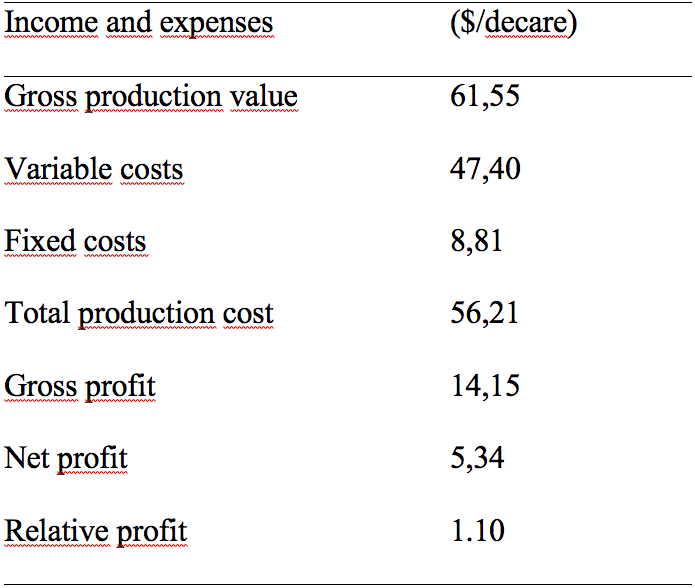
Source: Own elaboration.
Figure 2 shows the annual income and expenses of farms for wheat cultivation. It is seen that net profit was quite low.
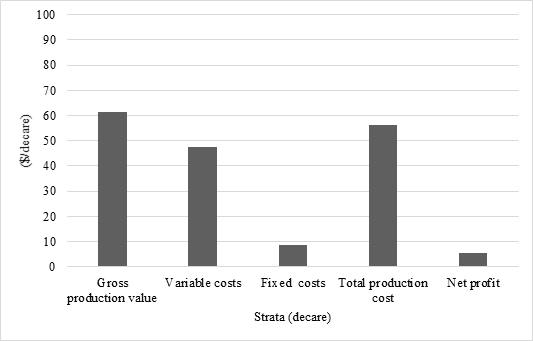 Fıgure 2
Income and expenses in Wheat Cultivation
Fıgure 2
Income and expenses in Wheat Cultivation
Source: Own elaboration.
Abandonment of Farmland Due to Producers’ Weak Administrative Competencies
In order to determine farms’ managemential profiles, their agricultural applications were investigated, and the results are shown in the following tables.
In Table 3, soil analysis sequences of farms were given. While 17.13% of farms always had the soil analysis, 14.36% of them had at times it, and 68.51% of them never had it. It was identified that 9.43% of small farms, 16.67% of middle farms, and 27.27% of big farms had soil analysis regularly. It was tested by a Chi-square whether the soil analysis sequence differed among the strata, and it was identified that it didn’t differ differences among the strata (c2test = 12,435).
Table 3
Dıstrıbutıon of soıl analysıs sequences of farms by strata
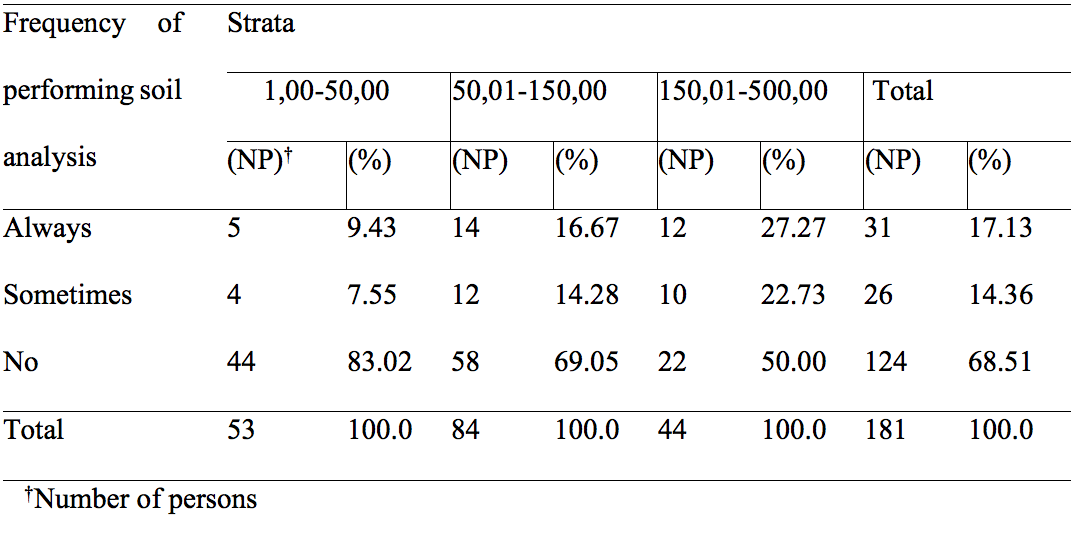
Source: Own elaboration.
In Figure 3, it is seen that the soil analysis of farms was scarce.
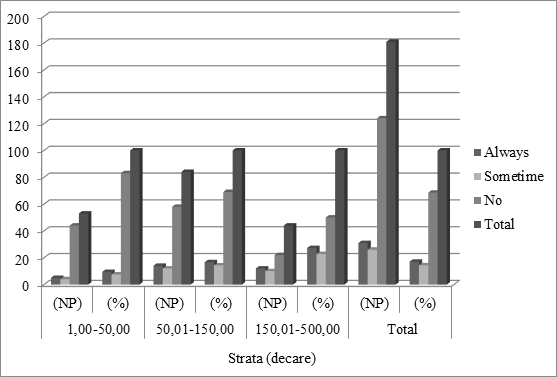 Fıgure 3
Dıstrıbutıon of soıl analysıs sequences of farms by strata
Fıgure 3
Dıstrıbutıon of soıl analysıs sequences of farms by strata
Source: Own elaboration.
In Table 4, distribution regarding farms’ determination of fertilizer consumption quantity was given. According to this, it was understood that 31.49% of producers determined according to own experiences, 30.39% of them according to results of soil analysis, 27.07% of them according to the recommendation of the Province and District Directorates of Agriculture, 6.63% of them as learned from his father/grandfather and 4.42% of them according to the recommendation of firms.
Table 4
Those taken as references for fertılızer use

Source: Own elaboration.
In addition to the above, 61.88% of the farms received technical support from the agricultural technicians/engineers, and 38.12% of them did not it (Table 5). As farm sizes enlarged, the ratio of those receiving technical support increased. The Chi-square test was used to determine whether the technical support situation changed according to the strata. By the Chi-square test, it was determined there wasn’t a significant difference among the strata in terms of receiving technical support (c2
test = 1,995). According to 92.73% of farms taking technical support, technical support was sufficiency, according to 7.27% of them, it wasn’t sufficiency.
Table 5
Dıstrıbutıon of farms takıng technıcal support by strata
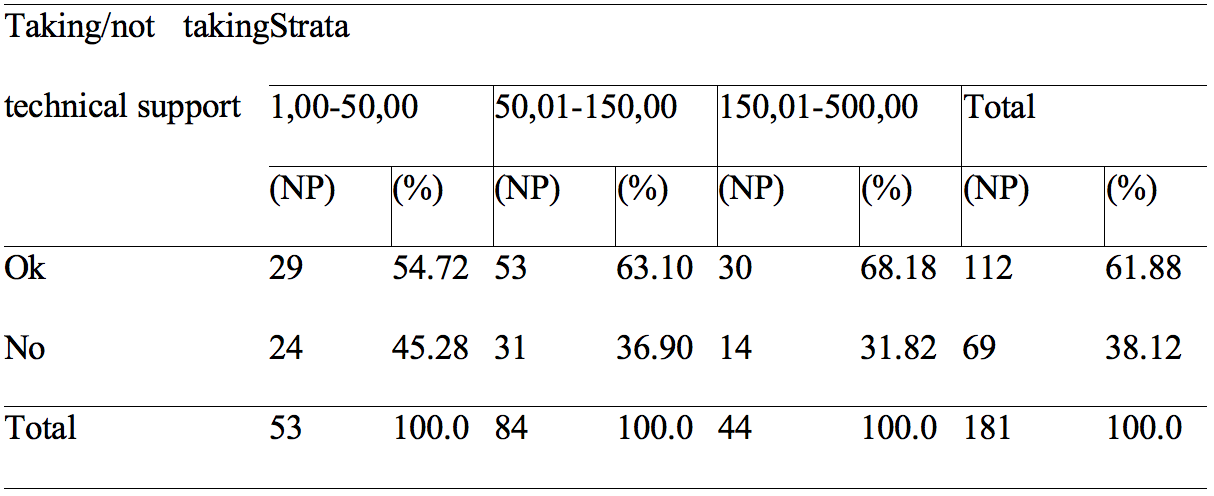
Source: Own elaboration.
In Figure 4, the ratio of farms taking technical support was given.
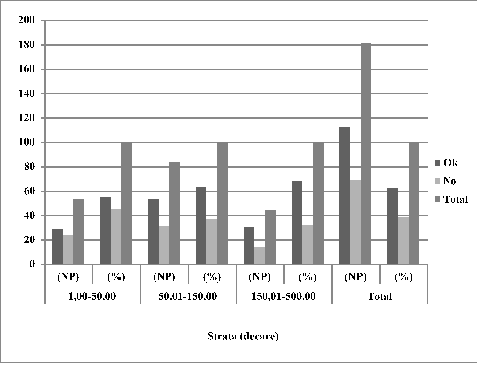 Fıgure 4
Distribution of farms taking technical support by strata
Fıgure 4
Distribution of farms taking technical support by strata
Source: Own elaboration.
In Table 6, whether the farms applied the cropping system or not was given. As 33.70% of the farms applied the cropping system, and 66.30% of them did not apply. Although the cropping system increased in parallel with the strata, there wasn’t a significant difference among them. In order to determine this, it was tested by the Chi-square, and it was determined there wasn’t any difference among the strata in terms of the cropping system (c2
test = 1,766).
Table 6
Dıstrıbutıon of farms applyıng croppıng system by strata
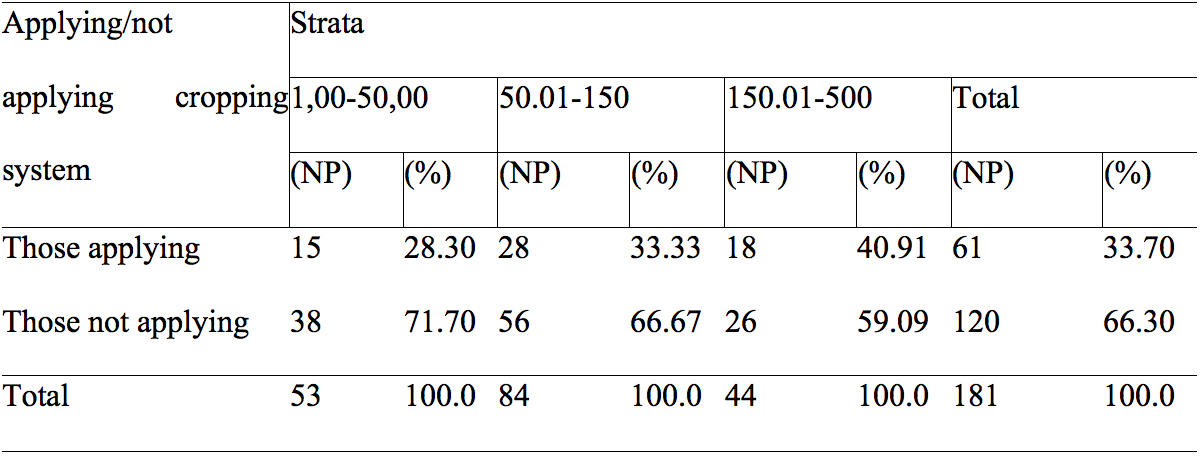
Source: Own elaboration.
In Figure 5, it is seen that the rate of farms applying cropping systems was rather low.
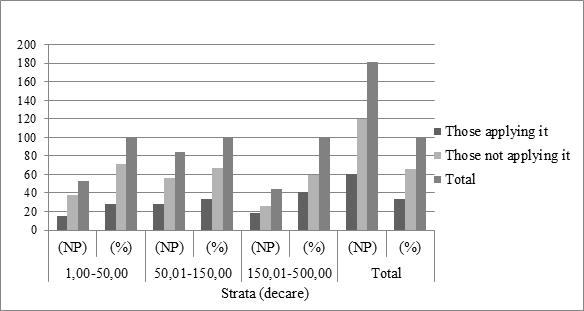 Fıgure 5
Dıstrıbutıon of farms applyıng croppıng system by strata
Fıgure 5
Dıstrıbutıon of farms applyıng croppıng system by strata
Source: Own elaboration.
Farms were also asked whether they were members of any producer organizations and their opinions about the organizations and given in Table 7. According to this, all the farms were members of the Chambers of Agriculture; 63.54% of them were members of the Agricultural Credit Cooperative; 21.55% of them were members of the Agricultural Development Cooperative; and 13.81% of them were members of the Sugar Beet Planters Cooperative. 69.61% of farms found useful the organizations, and 15.47% of them took office in the management of these organizations.
Table 7
Dıstrıbutıon of farms beıng a member of agrıcultural producer organızatıons by strata
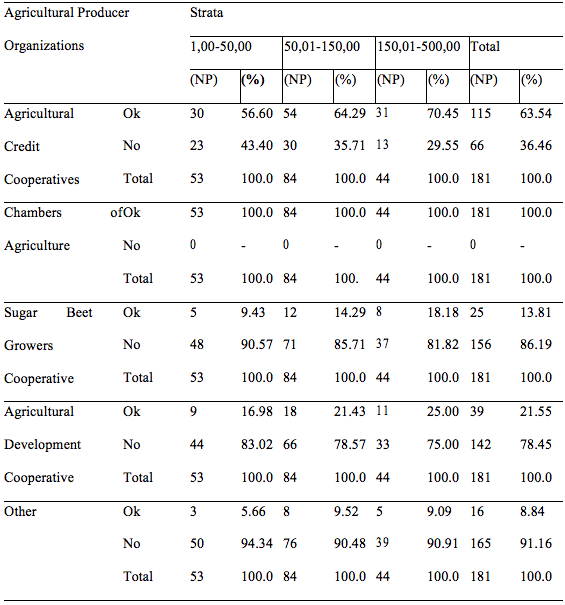
Source: Own elaboration.
Information on whether producers attend courses/meetings related to agriculture, and such organizations were useful given in Table 8. The attendance ratio for courses/meetings was 45.86%. Based on farm size, the participation rate also increased. Chi-square whether attendance at courses/meetings was different among the strata or not tested by Chi-square, and it was determined there were significant differences among them (c2
test = 6,392).
Table 8
Dıstrıbutıon of farms partıcıpatıng ın agrıcultural courses/meetıngs by strata
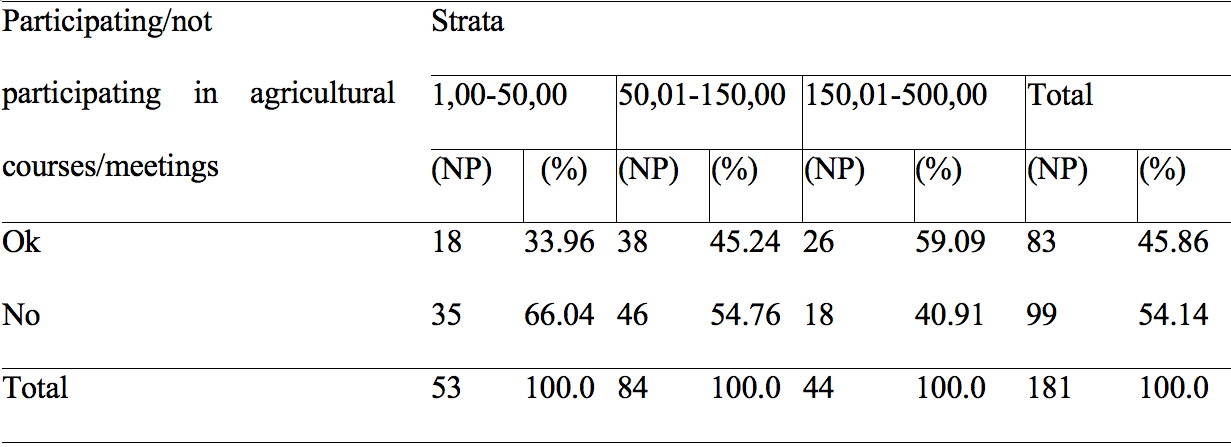
Source: Own elaboration.
In Figure 6, the distribution of farms participating in agricultural courses/meetings was given, and the rate of those participating in agricultural courses/meetings was also low.
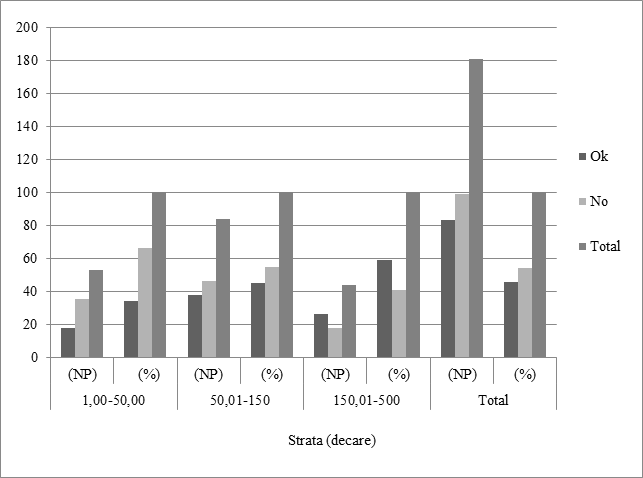 Fıgure 6
Dıstrıbutıon of farms partıcıpatıng ın agrıcultural courses/meetıngs by strata
Fıgure 6
Dıstrıbutıon of farms partıcıpatıng ın agrıcultural courses/meetıngs by strata
Source: Own elaboration.
Administrative profiles of farms show their success in agricultural practices. It is also important in measuring the overall success of farm management. 59.67% of farms were found a mid-profile and 12.15% of them had a high profile. Farms had weak and middle managemental profiles in general. It was tested by the Chi-square if producers’ administrative competence profiles differed among the strata. According to this, it was defined there were significant differences among the strata (c2test = 10,243).
In Figure 7, it is seen that farms’ administrative profiles were massed at weak and medium levels.
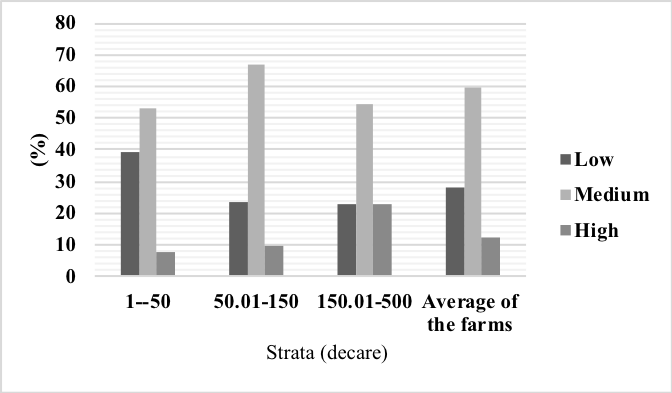 Fıgure 7
Farms’ Admınıstratıve profıles
Fıgure 7
Farms’ Admınıstratıve profıles
Source: Own elaboration.
Sustainability
In the study, in the light of the analysis of qualitative data, the following findings were reached on sustainability:
-
The government should resolve the reasons for agricultural land abandonment and take necessary measures in this regard.
-
Support prices should be determined by considering the production costs of all the regions.
-
Opinions of chambers of agriculture and agricultural cooperatives should be also taken into account in determining support prices.
-
Agricultural Institutions should see in situ agricultural activities.
-
Agricultural Institutions should provide technical assistance to farms on input use and agricultural activities.
-
The government should take all measures regarding agriculture to be an attractive sector.
Discussion
Agricultural lands are of great importance in meeting the nutrition needs of societies. Even when the subject is approached from this perspective, the importance of protecting agricultural lands will be understood.
In this research, the farms’ average annual income was detected at 4493.81 USD, and the annual minimum wage was determined at 5859.89 USD. Thus, the annual income was lower than the annual minimum wage obtained from the industry sector that year. Goldsmith et al. (2004) examined the relationship between agricultural productivity-abandonment of agricultural land using an econometric model in Senegal in 2004, and the findings supported the hypothesis that the abandonment of agricultural land was a positive function of the ratio of urban income per capita to rural income per capita.
In the study, it was determined that the main reasons for the abandonment of agricultural lands were low-income and farms’ weak administrative profiles. Some studies conducted on this topic in the academia were: Bühnemann et al. (1980) stated that in some regions of the European Economic Community, negative factors related to the nature of agriculture and other economic and social factors have led to the abandonment of agricultural lands. In a study conducted by Benayas et al. (2007) in Spain, it has been emphasized that the abandonment of agricultural lands is a phenomenon mostly caused by socioeconomic factors. Cengiz and Baydur (2010), in their study in Turkey, explained that abandoning agricultural land was basically an economic decision. Hussain et al. (2014) stated that the abandonment of agricultural lands in Malaysia was due to especially economic reasons and that it caused rural migrations, and migration is a population movement that changed society’s cultural, social, and political structure. In a study, Yılmaz (2015) conducted in Turkey, expressed that low income in the agricultural sector restricted rural employment, and so triggered the abandonment of agricultural lands. In the study conducted by Perpiña Castillo et al. (2020), it was specified that Spain has one of the most diverse climates in Europe, mainly due to its geographical location, continental mass and innumerable mountain ranges from north to south. These biophysical features, together with socio-economic and regional characteristics, pose a potential agricultural land abandonment risk for Spain. In other words, the most relevant factors driving land abandonment were identified as biophysical, agricultural economics, farm structure and demographic factors.
In the study, the reasons for land abandonment, which were found income and administrational (social)-oriented, were also the same reasons in studies conducted by Kabadayı et al. (2022), Crawford et al. (2022), Sciubba et al. (2021), Subedi et al. (2021) and Rajpar et al. (2019). By Sciubba et al. (2021), also, 24.5% of cultivated land had been abandoned in 50 years covering the period 1961-2011 in Southern Europe, and around 11% of EU agricultural land was at high risk of abandonment over the next years. By Karakayacı (2010), there were 26.4 million hectares of cultivated agricultural land in Turkey in 2000, and this rate decreased to 24.3 million hectares in 2009. Thus, the arable agricultural area decreased by 7.9% in 9 years.
When land abandonment rates (41.06% for total field land and 25.0% for total agricultural area) are compared with previous studies in this study, it can be said that a parallel result has been reached with those.
Land abandonment problems are experienced in other regions of Turkey, and even very many countries in the world. Since the study is original, no study to be compared with the findings of this paper was found in the literature. But, different projects related to the subject can be implemented in other regions. Thus, its negative impacts can be reduced by raising awareness about land abandonment.
Conclusion
The study showed that material gain was of primary importance in agricultural land abandonment. Since farms could reap not sufficient revenue from farmland, they had not cultivated it and abandoned it. The second factor that caused farms to farmland abandonment was the weak administrative profiles of farm owners. Administrative profiles of farms were massed as weak and medium levels. As owned land size increased, the administrative profile levels of farms also went up. Since the economy of the region was largely based on field crop cultivation, the use rationally of farmland was important in regard to the sustainability of agriculture.
To effectively mitigate the negative effects of land abandonment, the government should improve production conditions, improve agricultural yields, and strengthen food and agricultural product promotion and guidance, thereby promoting the rational use of arable land. Although it is thought that this study may have some basic shortcomings (conducted in a finite area, etc.), it is thought that it is going to contribute to conducting further studies in this field. In addition, the findings of this study can encourage the evaluation of arable land in other regions.
Acknowledgments
This study was produced from the Yozgat Bozok University Scientific Research Projects 6602a-SBMYO/18-167 coded BAP project.
References
Adenle, A. A., Wedig, K. & Azadi, H. (2019). Sustainable Agriculture and Food Security in Africa: The Role of İnnovative Technologies and İnternational Organizations. Technology in Society, 58. https://doi.org/10.1016/j.techsoc.2019.05.007
Afanasjeva, K., Kasparinskis, R. & Nikodemus, O. (2023). Spatial Relationships Between Soil Properties and Land Use Change after Agricultural Land Abandonment (No. EGU23-9891). Copernicus Meetings.
Benayas, J. R., Martins, A., Nicolau, J. M. & Schulz, J. J. (2007). Abandonment of Agricultural Land: An Overview of Drivers and Consequences. CAB Reviews: Perspectives in Agriculture, Veterinary Science, Nutrition and Natural Resources, 2(57), 1-14. http://dx.doi.org/10.1079/PAVSNNR20072057
Brodt, S., Six, J., Feenstra, G., Ingels, C. & Campbell, D. (2011). Sustainable Agriculture. Nat. Educ. Knowl, 3(1). https://www.nature.com/scitable/knowledge/library/sustainable-agriculture-23562787/
Bühnemann, W., Schreıber, K. F. & Bıllıon, F. (1980). Effects on the Environment of the Abandonment of Agricultural Land. Commision of the European Coomunities. https://aei.pitt.edu/36390/1/A2517.pdf
Cengiz, S. & Baydur, C. M. (2010). Migration From Rural to Urban and Agricultural Productivity: The Case of Turkey. Çukurova University Journal of Institute of Social Sciences, 19(2), 85-98.
Chopra, R., Magazzino, C., Shah, M. I., Sharma, G. D., Rao, A. & Shahzad, U. ( 2022). The Role of Renewable Energy and Natural Resources for Sustainable Agriculture in ASEAN Countries: Do Carbon Emissions and Deforestation Affect Agriculture Productivity? Resources Policy 76, 102578. https://doi.org/10.1016/j.resourpol.2022.102578
Cinemre, H. A. & Kılıç, O. (2015). Agricultural Economics (5th Edition). Ondokuz Mayıs University, Faculty of Agriculture.
Crawford, C. L., Yin, H., Radeloff, V. C. & Wilcove, D. S. (2022). Rural Land Abandonment Is Too Ephemeral to Provide Major Benefits for Biodiversity and Climate. Science Advances, 8(21), eabm8999. https://www.science.org/doi/10.1126/sciadv.abm8999
Dimopoulos, T., Helfenstein, J., Kreuzer, A., Mohr, F., Sentas, S., Giannelis, R. & Kizos, T. (2023). Different Responses to Mega-Trends in Less Favorable Farming Systems. Continuation and Abandonment of Farming Land on the Islands of Lesvos and Lemnos, Greece. Land Use Policy, 124, 106435. https://doi.org/10.1016/j.landusepol.2022.106435
Du, Z., Yang, J., Ou, C. & Zhang, T. (2021). Agricultural land abandonment and Retirement Mapping in the Northern China Crop-Pasture Band Using Temporal Consistency Check and Trajectory-Based Change Detection Approach. IEEE Transactions on Geoscience and Remote Sensing, 60, 1-12. https://doi.org/10.1109/TGRS.2021.3121816
Erbaş, N. (2016). Role and Importance of Agricultural Sector in Yozgat Economy. I. International Bozok Symposium, 4, 205-215.
Erbaş, N. (2021). Comparative Economic Analysis of Farms in Turkey and a Critical Assessment of the Annual Profitability: The Case of Yozgat Province. Custos e Agronegocıo on Lıne, 17(1), 332-460. http://www.custoseagronegocioonline.com.br/numero1v17/OK%2016%20comparative%20english.pdf
Erkuş, A. & Demirci, R. (1996). Agribusiness and Planning. Ankara University Faculty of Agriculture Publication No.
Fan, M., Shen, J., Yuan, L., Jiang, R., Chen, X., Davies, W. J. & Zhang, F. (2011). Improving Crop Productivity and Resource Use Efficiency to Ensure Food Security and Environmental Quality in China. Journal of Experimental Botany, 63(1), 13-24. https://doi.org/10.1093/jxb/err248
Fayet, C. M., Reilly, K. H., Van Ham, C. & Verburg, P. H. (2022). What Is the Future of Abandoned Agricultural Lands? A Systematic Review of Alternative Trajectories in Europe. Land use policy, 112, 105833. https://doi.org/10.1016/j.landusepol.2021.105833
Goldsmith, P. D., Gunjal, K. & Ndarishikanye, B. (2004). Rural-Urban Migration and Agricultural Productivity: The Case of Senegal. Agricultural Economics, 31(1), 33-45. https://doi.org/10.1093/jxb/err248
Hobbs, R. J. & Cramer, V. A. (2007). Why Old Fields? Socioeconomic and Ecological Causes and Consequences of Land Abandonment. Old fields: dynamics and restoration of abandoned farmland (pp. 1-14). Island Press.
Hussain, N. E., Abdullah, N. & Abdullah, H. (2014). The Relationship between Rural-Urban Migration, Household Income and Unemployment: Malaysia Case Study. International Journal of Managerial Studies and Research (IJMSR), .(8), 17-24. https://www.arcjournals.org/pdfs/ijmsr/v2-i8/3.pdf
Keskin, G. & Dellal, İ. (2011). Economic Sustainability of Sunflower Production in Thrace Region of Turkey. Journal of Environmental Protection and Ecology,12(1), 245-250.
Kabadayı, M. E., Ettehadi Osgouei, P. & Sertel, E. (2022). Agricultural Land Abandonment in Bulgaria: A Long-Term Remote Sensing Perspective, 1950-1980. Land, 11(10), 1855. https://doi.org/10.3390/land11101855
Karakayacı, Z. (2010). Evaluation of Misuse of Agricultural Lands in Terms of Sustainability Development. Agriculture Engineering, (355), 48-53. https://doi.org/10.1177/21582440241256840
Kazan, H. (2016). Scientific research techniques. Common Textbook. Istanbul University Publications.
Khor, M. (2009). The Food Crisis, Climate Change and the Importance of Sustainable Agriculture. Third World Network (TWN).
Kıncal, R., Şahin, Ç., Köse, E., Yeşil, R., Genç, S. Z., A. Özerbaş, Özkan, H.H., Bahar, H. H. & Özbek, R. (2022). Scientific Research Methods (7th Ed.). Nobel Academic Publishing.
Korkanç, S. Y. (2018). Effects of the Land Use/Cover on the Surface Runoff and Soil Loss in the Niğde-Akkaya Dam Watershed, Turkey. Catena, 163, 233-243. https://doi.org/10.1016/j.catena.2017.12.023
Leal Filho, W., Wu, Y. C. J., Brandli, L. L., Avila, L. V., Azeiteiro, U. M., Caeiro, S. & Madruga, L. R. D. R. G. (2017). Identifying and Overcoming Obstacles to the Implementation of Sustainable Development at Universities. Journal of Integrative Environmental Sciences, 14(1), 93-108. https://doi.org/10.1080/1943815X.2017.1362007
Majchrowska, A. (2013). Abandonment of Agricultural Land in Central Poland and its Ecological Role. Ekológia (Bratislava), 32(3), 320-327. https://doi.org/10.2478/eko-2013-0028
Masny, M. & Zauskova, Ľ. (2014). The Abandonment of Agricultural Land: A Case Study of Strelníky, (the Poľana Biosphere Reserve–Slovakia). Carpathian Journal of Earth and Environmental Sciences, 9(3), 17-24. https://www.cjees.ro/viewTopic.php?topicId=441
Özçelik, A. (2019). Agribusiness and Farming Management Planning (1st Ed.). Ekin Publishing.
Perpiña Castillo, C., Coll Aliaga, E., Lavalle, C. & Martínez Llario, J. C. (2020). An Assessment and Spatial Modelling of Agricultural Land Abandonment in Spain (2015-2030). Sustainability, 12(2), 560. https://doi.org/10.3390/su12020560
Purvis, B., Mao, Y. & Robinson, D. (2019). Three Pillars of Sustainability: İn Search of Conceptual Origins. Sustainability science, 14(3), 681-695. https://doi.org/10.1007/s11625-018-0627-5
Rajpar, H., Zhang, A., Razzaq, A., Mehmood, K., Pirzado, M.B. & Hu, W. (2019). Agricultural Land Abandonment and Farmers’ Perceptions of Land Use Change in the Indus Plains of Pakistan: A Case Study of Sindh Province. Sustainability. https://doi.org/10.3390/su11174663
Rehber, E. & Tipi, T. (2016). Agribusiness and Planning (3rd Ed.). Ekin Publishing.
Rehber, E. & Vural, H. (2018). Agricultural Economics (2nd Ed.). Ekin Publishing.
Rehber, E. & Erkuş, A. (2020). Project Preparation Technique in Agriculture. Ekin Publishing.
Robertson, G. P. (2015). A Sustainable Agriculture? Daedalus, 144(4), 76-89. https://doi.org/10.1162/DAED_a_00355
Schaller, N. (1993). The Concept of Agricultural Sustainability. Agriculture, ecosystems & environment, 46(1-4), 89-97. https://doi.org/10.1016/0167-8809(93)90016-I
Sciubba, L., Mazzon, M., Cavani, L., Baldi, E., Toselli, M., Ciavatta, C. & Marzadori, C. (2021). Soil Response to Agricultural Land Abandonment: A Case Study of a Vineyard in Northern Italy. Agronomy, 11(9), 1841. https://doi.org/10.3390/agronomy11091841
Subedi, Y. R., Kristiansen, P., Cacho, O. & Ojha, R. B. (2021). Agricultural Land Abandonment in the Hill Agro-ecological Region of Nepal: Analysis of Extent, Drivers and Impact of Change. Environmental Management, 67,1100-1118. https://doi.org/10.1007/s00267-021-01461-2
Subedi, Y. R., Kristiansen, P. & Cacho, O. (2022). Drivers and Consequences of Agricultural Land Abandonment and its Reutilisation Pathways: A Systematic Review. Environmental Development, 42, 100681. https://doi.org/10.1016/j.envdev.2021.100681
Terzi, İ., Özgüven, M. M., Altaş, Z. & Uygun, T. (2019). Use of Artificial Intelligence in Agriculture. Erciyes University International Erciyes Agriculture, Animal & Food Sciences Conference, Turkey.
Turkish Statistical Institut (TSI). (2017). News/Bulletins. Author. https://www.tuik.gov.tr/
Turkish Statistical Institut (TSI). (2021). News/Bulletins. Author. https://www.tuik.gov.tr/
Yamane, T. (2006). Basic Sampling Methods (A. Esin, M. A. Bakır, C. Aydın, E. Güzbüzsel, Trans.). Literature Publications.
Yılmaz, M. (2015). Change of Rural Population in Turkey and and Its Distribution by Provinces (1980-2012). Eastern Geographical Review, 20(33), 161-188. https://doi.org/10.17295/dcd.71070
Velten, S., Leventon, J., Jager, N. & Newig, J. (2015). What is Sustainable Agriculture? A Systematic Review. Sustainability, 7(6), 7833-7865. https://doi.org/10.3390/su7067833
Notes
*
Research article.
Author notes
a Correspondence author. Email: nizamettin.erbas@bozok.edu.tr
Additional information
How to cite: Erbaş, N. & Çınarer, G. (2024). Abandonment of Agricultural Lands, Reasons and Sustainability: Evidence from Turkey. Cuadernos de Desarrollo Rural, 21. https://doi.org/10.11144/Javeriana.cdr21.aalr











 (1)
(1) (2)
(2) (3)
(3) (4)
(4)  (5)
(5) (6)
(6) (7)
(7) (8)
(8)













